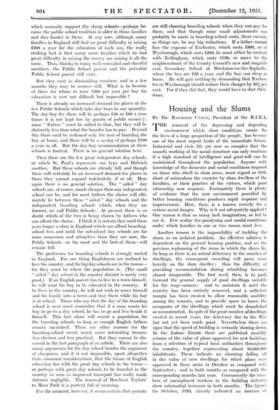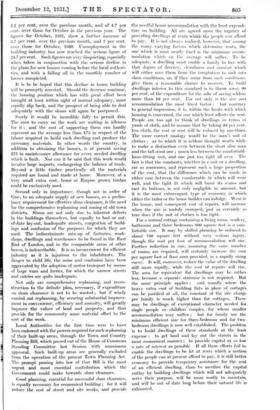Housing and the Slums By Da. RAYMOND UNW1N, President of
the R.I.B.A: THE removal of the depressing and degrading environment which slum conditions create for the lives of a large proportion of the people, has become one of the most urgent tasks of the immediate future. Industrial and civic life are now so - complex that the smooth working of the social structure can only continue if a high standard of intelligence and good will can be maintained throughout the population. Anyone with knowledge of the domestic and social conditions imposed on those who dwell in slum areas, must regard as little short of miraculous the exercise by slum dwellers of the faculties, or their practice of the virtues, which good citizenship now requires. Fortunately there is plenty of evidence that the new environment provided by better housing conditions produces rapid response and improvement. Here, then, is a known remedy for a serious social danger. Why is it not adequately applied ? One reason is that so many lack imagination, or fail to use it. Few realize the paralysing and sordid conditions under which families in one or two rooms must live.
Another reason is the impossibility of tackling the slums as an isolated problem. An effective solution is dependent on the general housing position, and on the previous replanning of the areas in which the slums lie. So long as there is an actual deficiency in the number of dwellings, the consequent crowding -will press most heavily on the slum dweller ; thus the difficulty of providing accommodation during rebuilding becomes almost insuperable. The first need, then, is to push forward the general supply of good dwellings suitable for the wage-earners ; and to maintain it until the scarcity has been entirely removed, and a sufficient margin has been created to allow reasonable mobility among the tenants, and to provide space to house the occupants of the dwellings which must be demolished or reconstructed. In spite of the great number of dwellings erected in recent years, the deficiency due to the War has not yet been made good. Nevertheless there arc signs that the speed of building is seriously slowing down: In the Labour Gazette there are published monthly returns of the value of plans approved for new buildings from- a selection of typical local authorities throughout the country, together representing about 16,000,000 inhabitants. These indicate an alarming falling off in the value of new dwellings for which plans were approved in these- areas in October as Compared with September ; and in both months as compared with the corresponding months last year. Concurrently the num- bers of ,unemployed workers in the building industry show substantial 'increases in both months: The figures for 'October, 1930, already indicated an increase of 2.2 per cent. over the previous month, and of 4.7 per cent. over those for October in the previous year: The figures for October, 1931, show a further increase of 3.7 per cent. over the previous month, and 7 per cent. over those for October, 1930. Unemployment in the building industry has now reached the serious figure of 24.7 per cent. Such figures are very disquieting, especially when taken in conjunction with the serious decline in the plans for new houses coining before the local authori- ties, and with a falling off in the monthly number of houses completed.
It is to be hoped_ that this decline in house building will be promptly arrested. Should the decrease continue, the housing position which has with great effort been brought at least within sight of normal adequacy, must rapidly slip back, and the prospect of being able to deal adequately with the slums will again be postponed.
Surely it would be incredible folly to permit this. The men to carry on the work are waiting in idleness for it : and the cost of supporting them can hardly represent on the average less than 175 in respect of the labour required to build each dwelling and produce the necessary materials. In other words the country, in addition to obtaining the houses, is at present saving £75 in maintenance allowance for every needed dwelling which is built. Nor can it be said that this work would involve large imports, endangering the balance of trade. Beyond a little timber practically all the materials required are found and made at home. Moreover, at a very small extra cost, home or Empire grown timber could be exclusively used.
Second only in importance, though not in order of time, to an adequate supply of new houses, as a prelim- inary requirement for effective slum clearance, is the need for the comprehensive replanning and zoning of old town listricts. Slums are not only due to inherent defects M the buildings themselves, but equally to bad or out- -of-date lay-out, inadequate streets, congestion of build- ings and confusion of the purposes for which they are used. The indiscriminate mix-up of factories, work- shops, dwellings and warehouses to be found in the East pnd of London, and in the comparable areas of other towns, is indescribable. It is as inconvenient for efficient industry as it is injurious to the inhabitants. The hanger to child life, the noise and confusion have been aggravated by the adoption of motor transport by means of large vans and lorries, for which the narrow streets and entries are quite inadequate.
Not only are comprehensive replanning, and recon- struction to the definite plan, necessary, - if expenditure on slum clearance is not to be wasted ; but if wisely carried- out- replanning, by securing substantial improve- ment in convenience, efficiency and amenity, will greatly improve the values of land and property, and thus provide for the community some material offset to the cost of the work.
Local Authorities for the first time were to have been endowed with the powers required for such replanning of their built-up areas, through the Town and Country Planning Bill, which passed out of the House of Commons Standing Committee last Session with unanimous approval. Such built-up areas are generally excluded from the operation of the present Town Planning Act. The prompt passing into law of that Bill is the most urgent and most essential contribution which the Government could make towards slum clearance.
Good planning, essential for successful slum clearance, is equally necessary for economical building ; for it will reduce the cost of street and site works, and provide the needful house accommodation with the least expendi- ture on building. All are agreed upon the urgency of providing dwellings at rents Wide the people can afford to pay. It is not always realized, however, that among the many varying factors which determine rents, the one which is most nearly fixed is the minimum accom- modation which on the average will suffice. To be adequate, a dwelling must enable a family to live with that degree of decency, cleanliness and comfort which will either save them from the temptation to sink into slum conditions, or, if they come from such conditions, give them a reasonable chance to recover. To build dwellings inferior to this standard is to throw away 90 per cent. of the expenditure for the sake of saving seldom more than 10 per cent. For not only is the size and accommodation the most fixed factor ; but contrary to general impression, it is, within the limits with which housing is concerned, the one which least affects the rent. People are too apt to think of dwellings in terms of yards of cloth, and to assume that by taking 33 per cent. less cloth, the cost or rent will be reduced by one-third. The. more correct analogy would be the man's suit of clothes ; as to which it is seldom thought worth while to make a distinction even between the short slim man and the tall stout one ; much less between the comfortable loose-fitting suit, and one just too tight all over. The fact is that the constants, whether in a suit or a dwelling, are so numerous, and represent such a large proportion of the cost, that the difference which can be made in either ease between the comfortable fit which will wear well, and the tight fit which will burst its seams and cast its buttons, is not only negligible in amount, but it is the most extravagant type of economy in which either the tailor or the house builder can indulge. Wear in the house, and consequent cost of repairs, will increase when the size is unduly cramped, just as certainly as tear does if the suit of clothes is too tight.
For a normal cottage containing a living room, scullery, bathroom and three bedrooms 800 square feet is a com- fortable size. It may by skilled planning be reduced to about 700 square feet without very serious injury, though the cost per foot of accommodation will rise. Further reduction in size, assuming the same number of rooms are required, will certainly increase the cost per square foot of floor area provided, in a rapidly rising curve. It will, moreover, reduce the value of the dwelling still more rapidly, while the cost of repairs will rise. The area for equivalent flat dwellings may be rather less, because a separate staircase is not required. But the same principle applies ; and usually where the heavy • extra cost of building flatS in place of cottages can be justified at all, the constant of the site charge per family is much higher than for cottages. There may be dwellings of exceptional character needed for single people or childless couples, for whom smaller accommodation may suffice ; but for family use the minimum efficient size for three-bedroom and for two- bedroom dwellings is now well established. The problem is to build dwellings of these standards at the least expense ; to get land and lay out the streets in the most economical manner ; to provide capital at as low a rate of interest as possible. If all these efforts fail to enable the dwellings to be let at rents which a section of the people can at present afford to pay, it is still better economy to provide temporary assistance for the rent of an efficient dwelling, than to sacrifice the capital outlay by building dwellings which will not adequately serve their purpose, will be more costly to maintain, and will be out of date long before their natural life is exhausted.











































 Previous page
Previous page